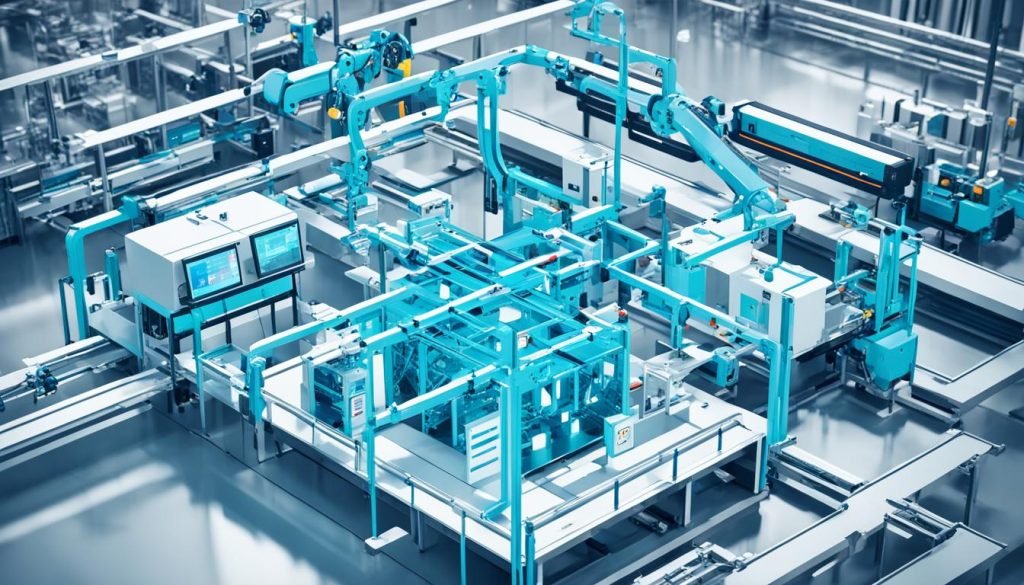For manufacturers, optimizing the supply chain is key to better efficiency and lower costs. By making processes leaner and using smart strategies, they cut down on waste and reduce risks. This leads to quicker and more accurate deliveries.
They excel by keeping an eye on key performance indicators (KPIs) to spot where they can do better. This constant data analysis helps them lower expenses, upgrade production, and please their customers. Using special software and data, manufacturers improve their view of the supply chain, spot problems, and make operations smoother. This means better processes, lower expenses, and happier customers.
In today’s fast-paced market, quick deliveries are a must and meeting this need is important for manufacturers. Also, reducing operational risks is vital. They create strategies for when they face part sourcing issues and make sure warehouses run smoothly. Working closely with suppliers and planning transportation well helps keep the flow of products steady.
Key Takeaways:
- Supply chain optimization boosts manufacturing efficiency and cuts costs.
- Monitoring KPIs and tweaking processes is key for success.
- Using software and data helps a lot with optimization.
- Optimizing the supply chain means lower costs and happier customers.
- Good backup plans, warehouse organization, and transportation strategies are central to optimization.
What is Supply Chain Optimization?
Supply chain optimization means making the supply chain of manufacturers work better and cost less. This covers the path from designing a product to selling it. The aim is to make more money and spend less by always checking how well things are going and fixing what’s not working.
Making everything work faster and better is the main goal. This makes the whole process smooth, without needless delays or wasted resources. By doing this, companies can make things quicker, use time better, and meet what customers want more effectively.
Then, there’s the focus on saving money. Manufacturers look for ways to spend less all along the chain. This might mean using less material, managing stock better, or finding smarter ways to move goods. Doing this cuts down on costs and adds to their profits.
Staying clear of any trouble from the law is also important. Following rules and preparing for unexpected events keeps the chain running smoothly. For example, having a backup plan for getting parts can prevent big problems.
Getting products to customers on time and right is crucial. With good supply chain work, companies figure out faster and smarter ways to ship and store products. They use special software to keep everything moving well, which keeps customers happy.
Optimizing the supply chain happens all the time. Checking delivery times and customer happiness is a must. New tech like AI helps by spotting issues and improving the way things work.
In the end, making the supply chain work better means less risk, more efficiency, and happier customers. Always trying to do better and using smart strategies helps companies stay ahead and do well for years to come.
The Importance of Supply Chain Optimization
Supply chain optimization is key for business success. It ensures top efficiency, cuts costs, and meets customer demands. In today’s market, customers want a lot – from various products to low prices and fast delivery.
By streamlining their supply chains, businesses reduce expenses, react fast to problems, and up their customer service. This boosts customer happiness and loyalty.
“Supply chain optimization is not just about reducing costs; it’s about delivering value to customers efficiently, effectively, and consistently.”
– John Smith, Supply Chain Expert
One major plus of a tight supply chain is lowering costs for waste, shipping, and stock control. By using the right processes and tech, companies cut material waste, find the best delivery routes, and better handle their warehouses. This slashes how much they spend and lifts their profit. It also lets them react fast to problems, like not enough supplies, to keep production and delivery on track.
Making the supply chain better also makes customers happier. It quickens delivery and makes it more accurate, meeting expectations for fast and reliable products. This keeps customers happy and more likely to come back or recommend the business.
Working on the supply chain helps everyone in the system. By working closer with suppliers, businesses improve communication, make things smoother, and build better relationships. This teamwork can cut costs and run better for everyone involved.
Besides saving money and making customers happier, a good supply chain helps make better products. By fine-tuning processes and checking quality well, businesses make sure their products are top-notch every time. This means fewer returns or complaints, making customers even more satisfied and saving the company money.
At the end of the day, a well-done supply chain means more money for the business. Lower costs and better service set the stage for higher profits and a great standing in the marketplace. This can also lead to more chances to grow and expand the business.
| Benefits of Supply Chain Optimization | Risks of Neglecting Supply Chain Optimization |
|---|---|
| Improved supply chain efficiency | Increased operational costs |
| Reduced costs | Customer dissatisfaction |
| Enhanced customer satisfaction | Supply chain disruptions |
| Strengthened supply chain ecosystem | Decreased product quality |
| Improved product quality | Missed revenue opportunities |
| Increased revenue and profits | Competitive disadvantage |
Investing in supply chain optimization brings many perks, from better efficiency to happier customers and more money. It’s crucial for businesses to focus on this for their ongoing success in a competitive market.
Techniques for Supply Chain Optimization
Businesses can boost efficiency, lower costs, and up their game by optimizing their supply chain. They can do this through various methods. These include:
1. Cost Optimization
Focusing on cost optimization looks at different parts of the supply chain. It seeks to find where spending can be cut or money can be saved. By looking at costs of transport, storage, inventory, and making products, businesses can see places to save. They might choose to combine suppliers, make new deals, or find cheaper sources. These steps can bring big savings.
2. Inventory Optimization
Managing stock well is key to a lean supply chain. By fine-tuning how much stock they keep, companies can spend less on storage and still meet customer needs fast. They might use JIT or better forecasting to keep the right amount of stock on hand without overdoing it.
3. Network Optimization
Network optimization is about keeping the supply chain in top shape. It involves looking at things like shipping routes, where to store goods, and where suppliers are. By making smart choices in design, companies can cut the time it takes to get goods out, save on shipping, and work smoother overall. They can choose shorter routes, combine storage hubs, and use data to find weak spots and fix them.
4. Software Solutions
Software like ERPs, B2B systems, and analytics can make managing the supply chain much smoother. ERPs link up all parts of a business, making it easier to make good choices and use resources well. B2B systems help companies and partners work better together by improving how they talk and share info. Analytics let businesses see into the future, spotting problems before they happen and fine-tuning operations.
By using all these methods, companies can not just save money but also do better with their suppliers, work more closely together, and have a more effective supply chain. This means they can put out higher quality products, make customers happier, and stand out from their competition.

Conclusion
Supply chain optimization is key in making businesses more efficient. It helps them cut costs and stand out in the market. Companies use tools to keep an eye on how well they’re doing. This helps them find ways to get better, like managing costs, handling their stock well, and making their networks work better.
Using the right software and working closely with suppliers can make a big difference. It lets companies work together well and make smart choices based on data. This improves how they do things, makes customers happier, and helps the business grow.
Choosing to focus on supply chain optimization helps businesses in many ways. It lets them meet what their customers need, lowers the chance of problems, and makes them more money. And it’s not just a one-time thing. It’s about always finding ways to be better. This way, businesses are ready for whatever changes come along and they stay in the lead.




